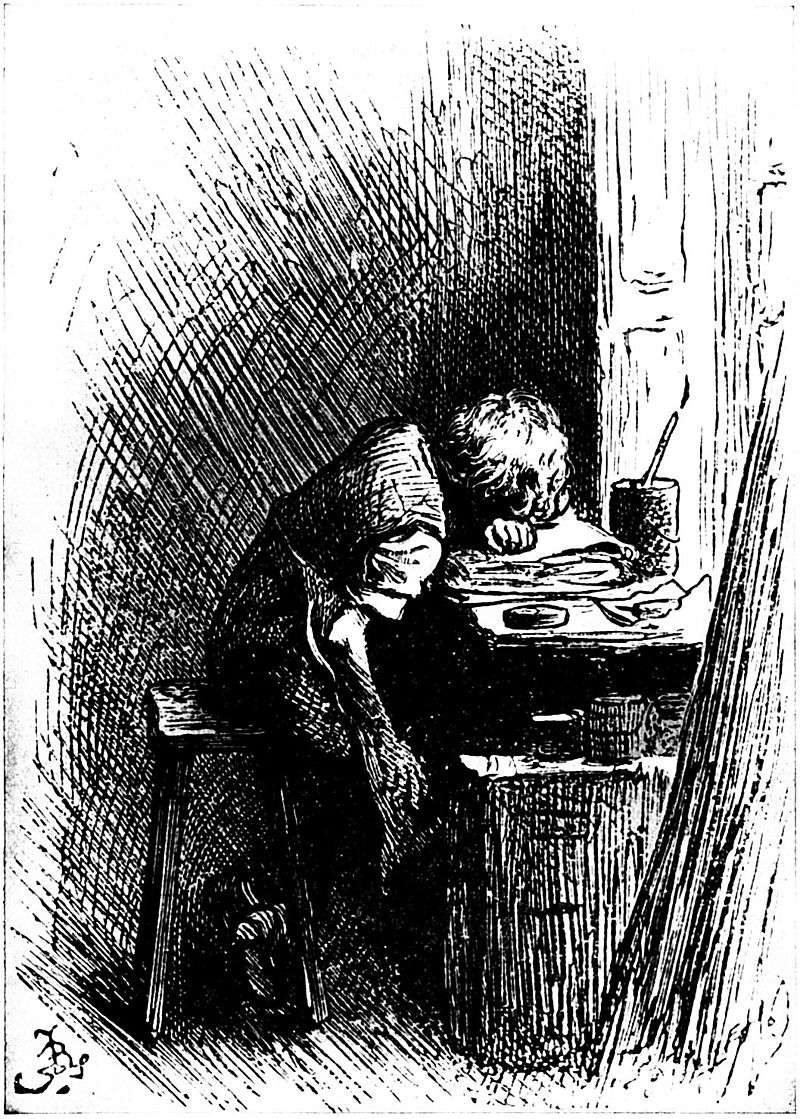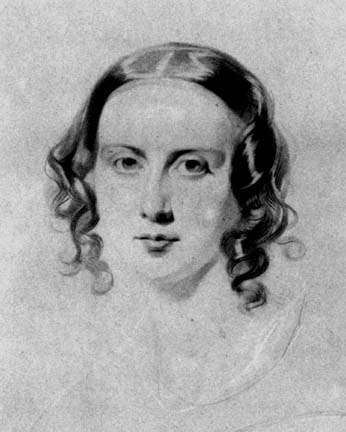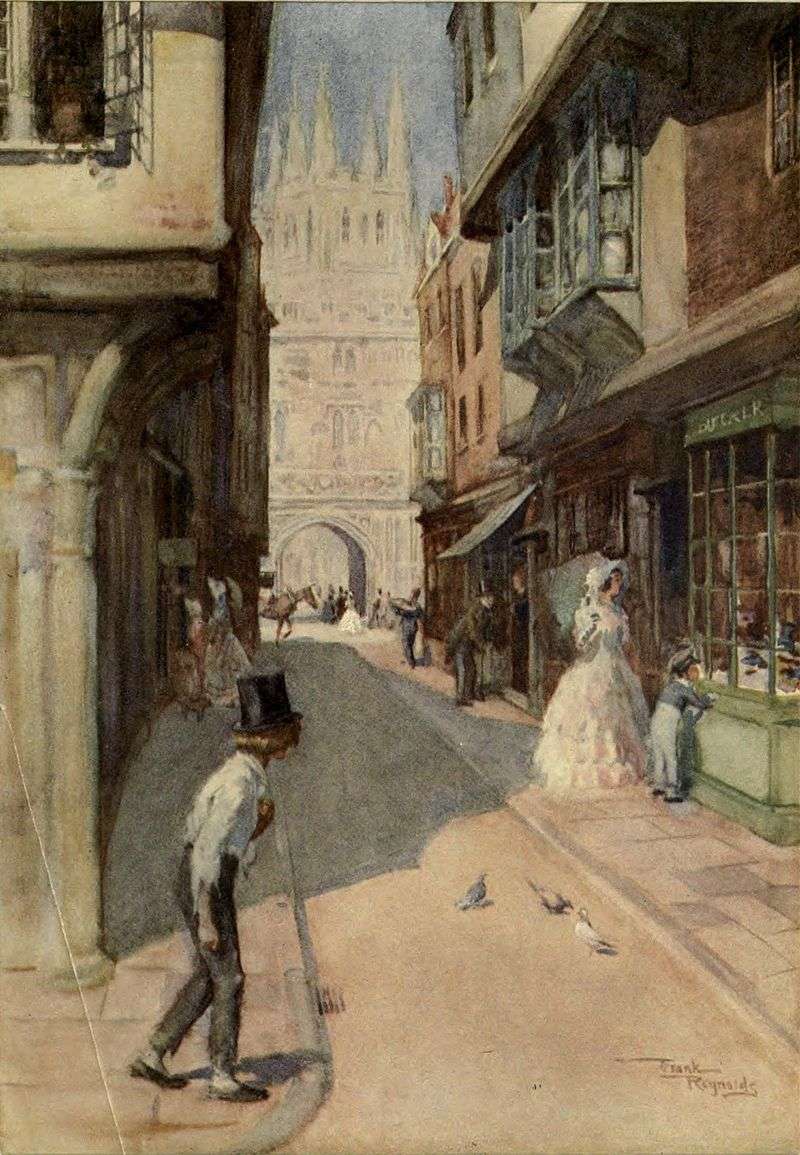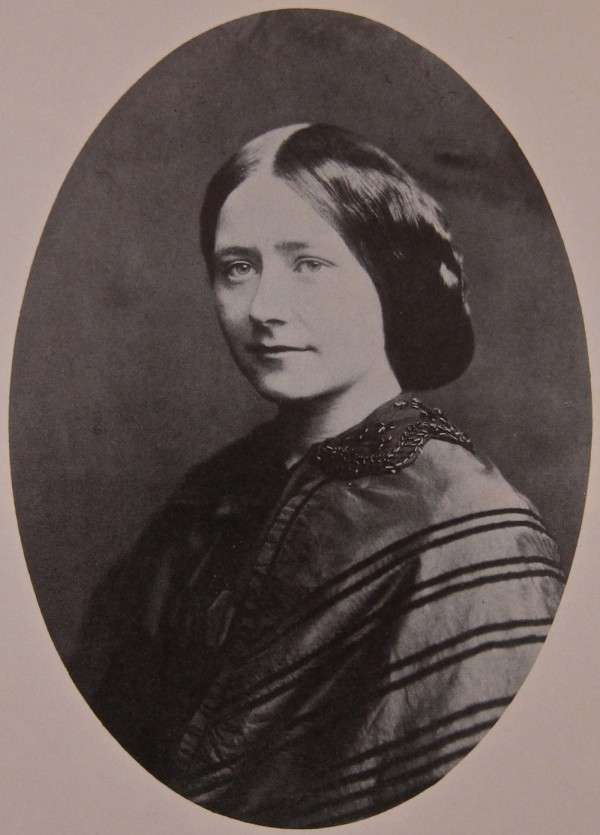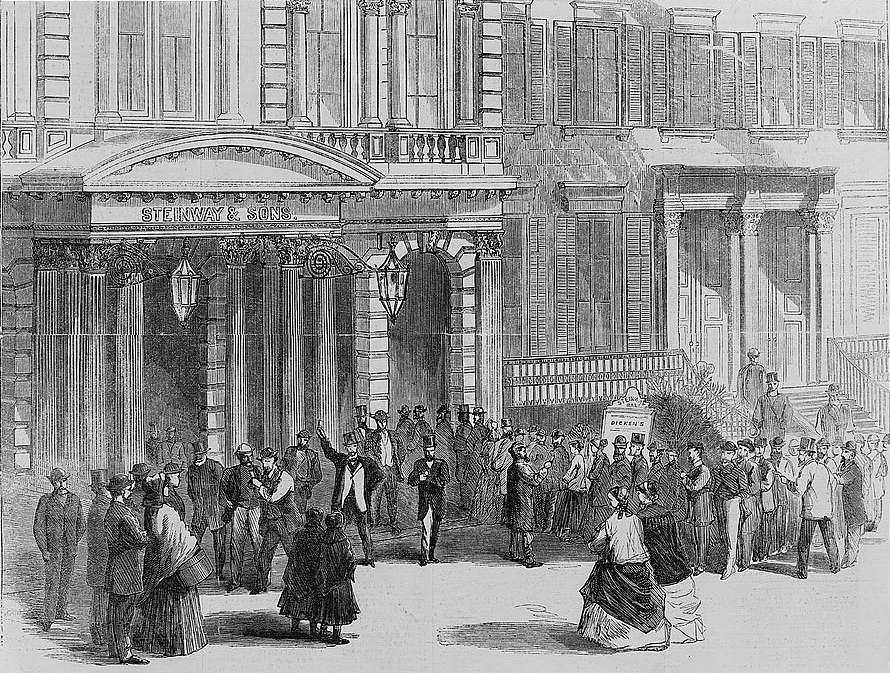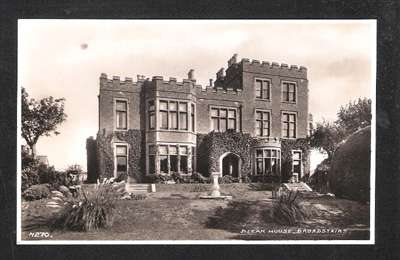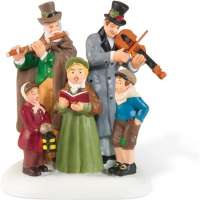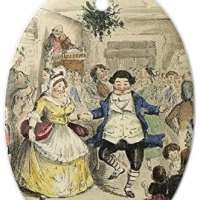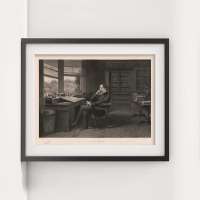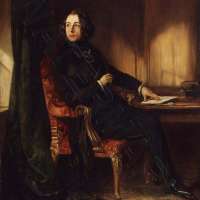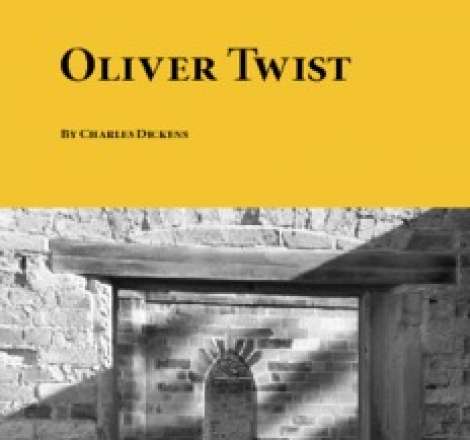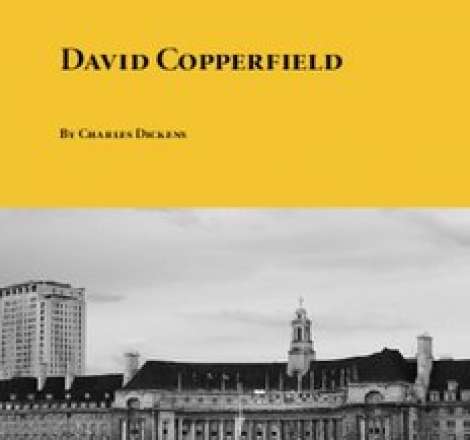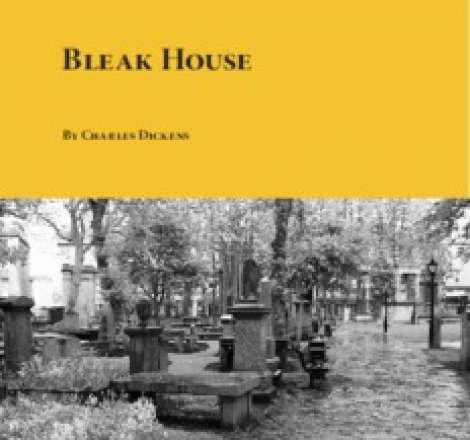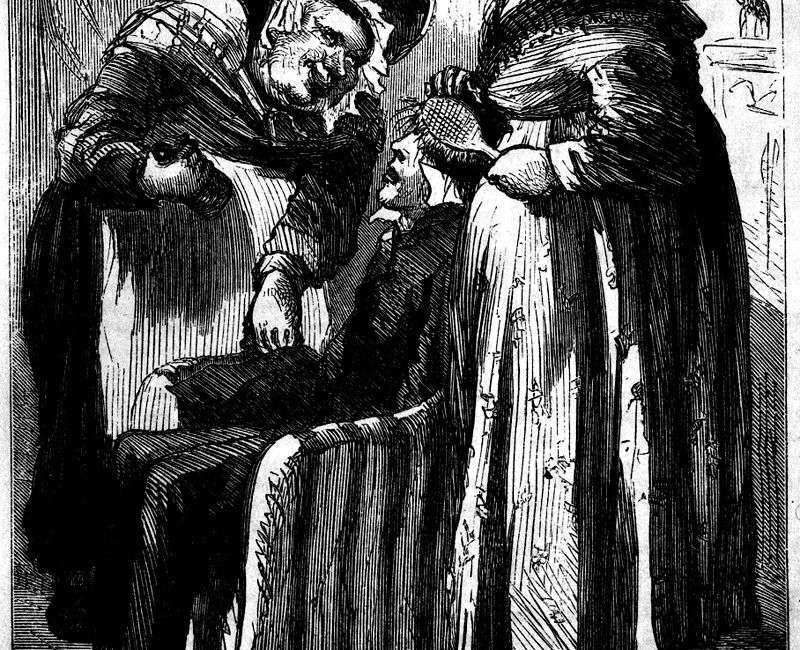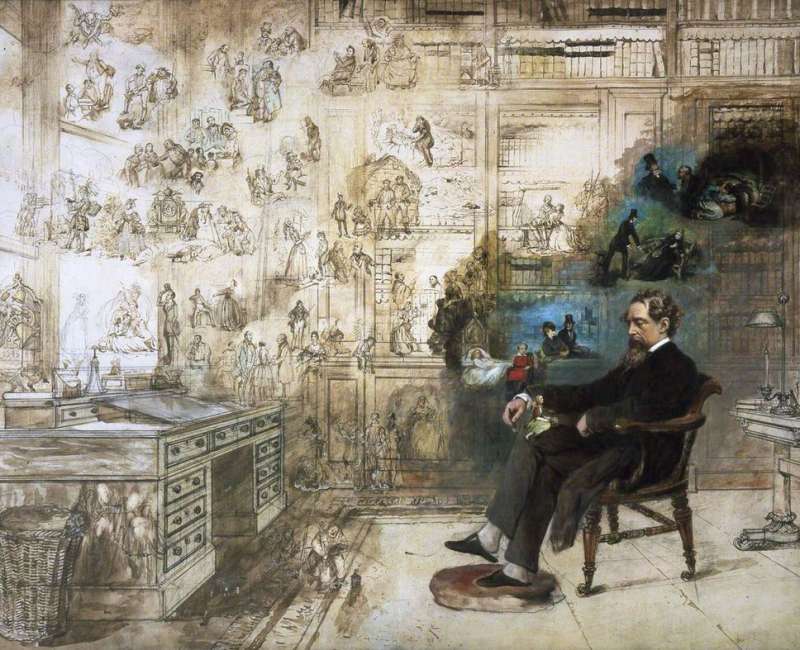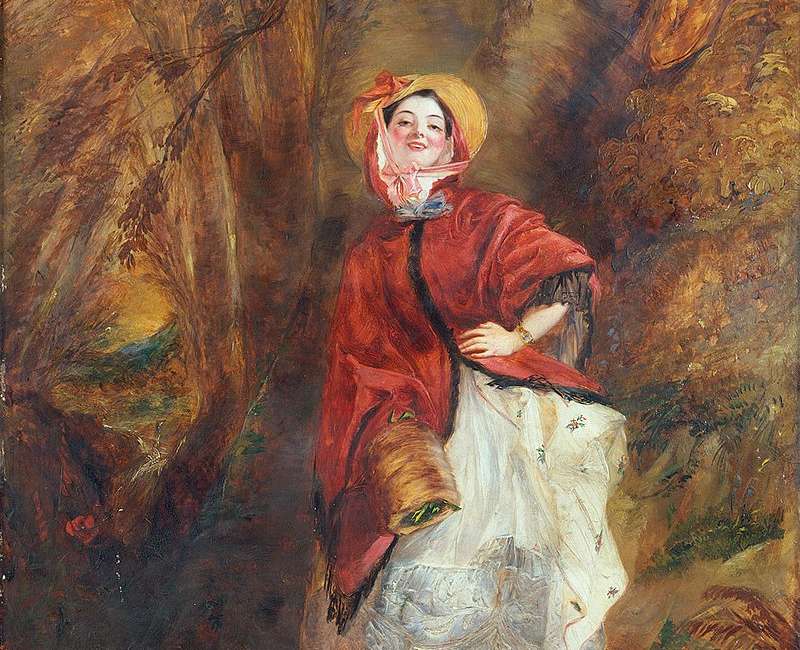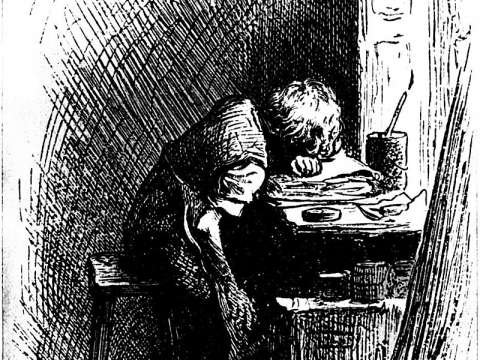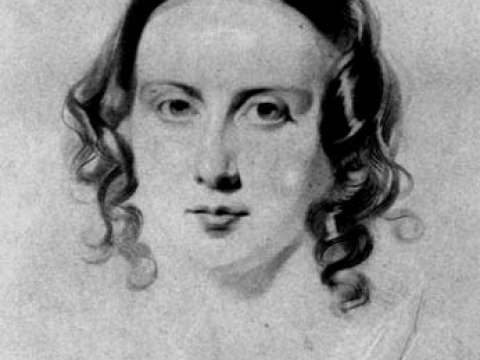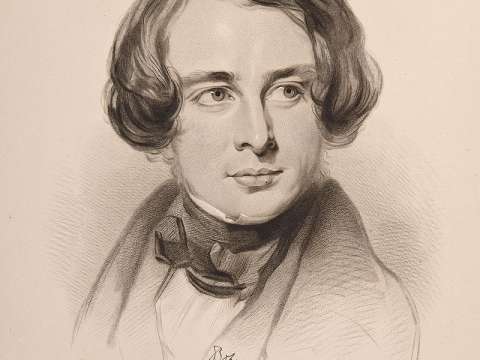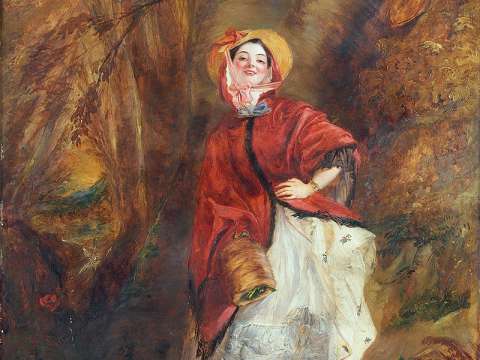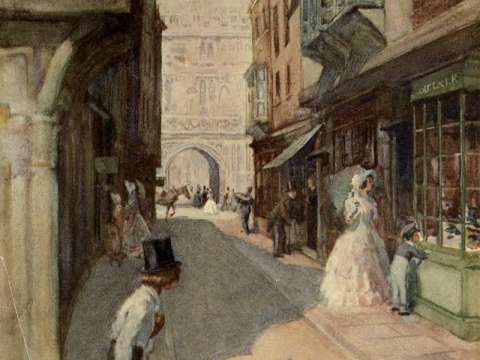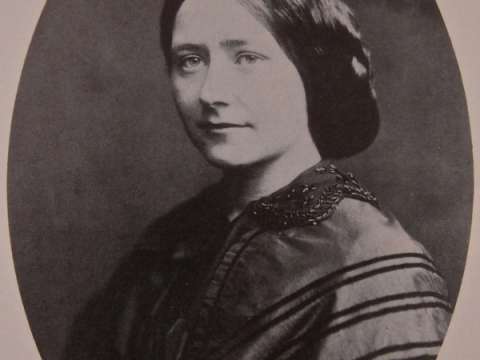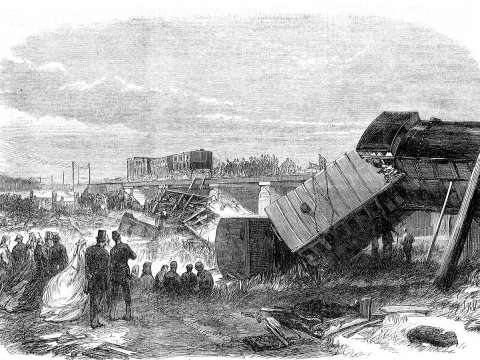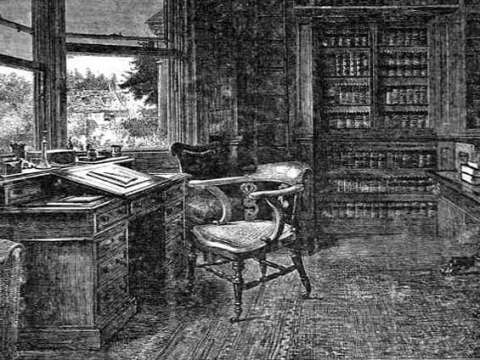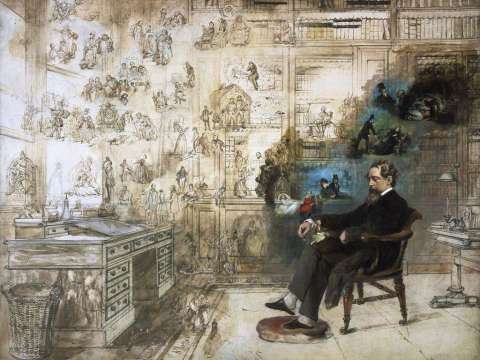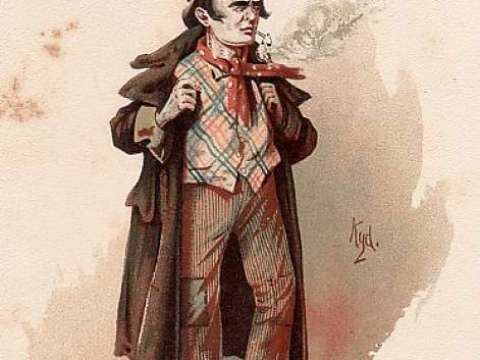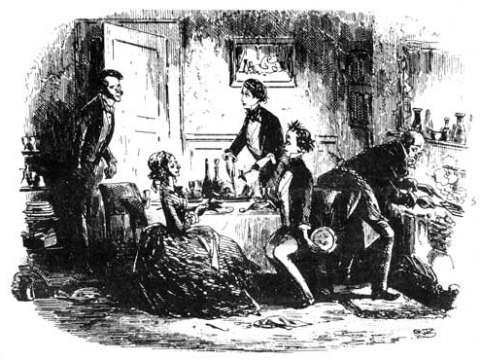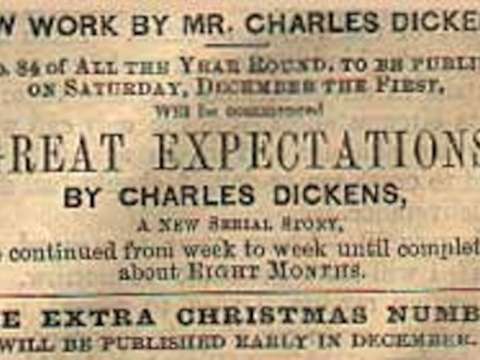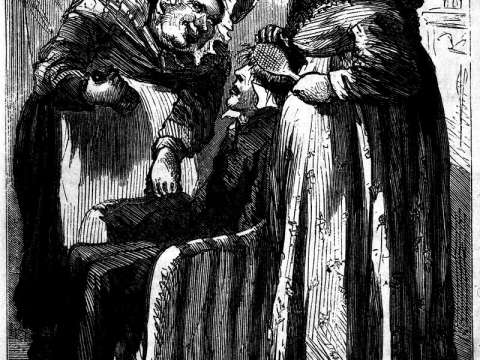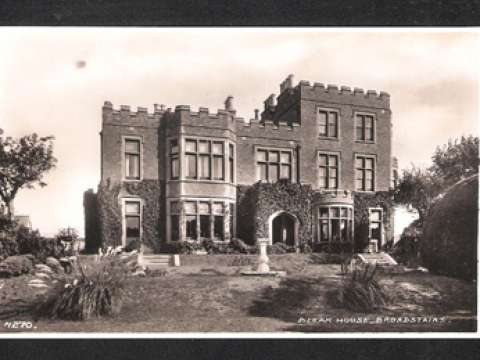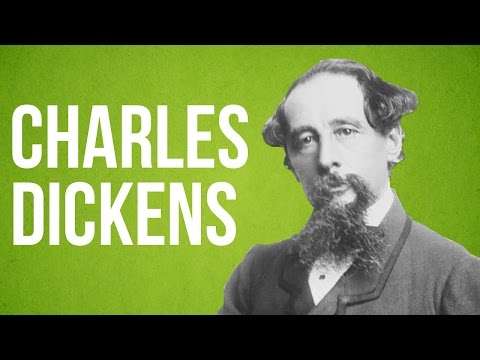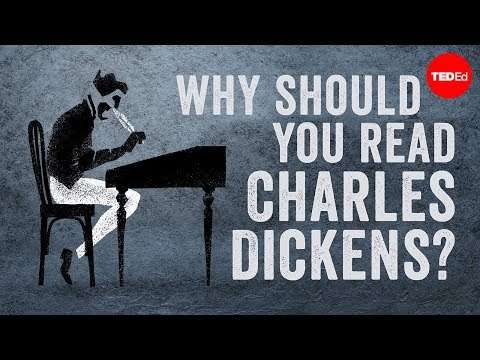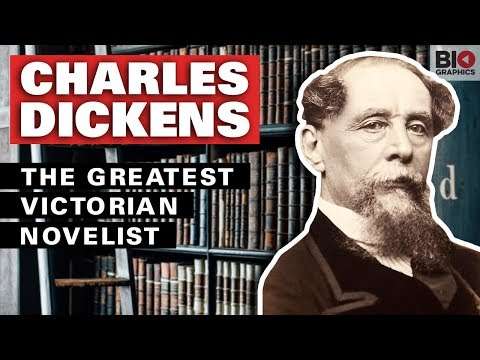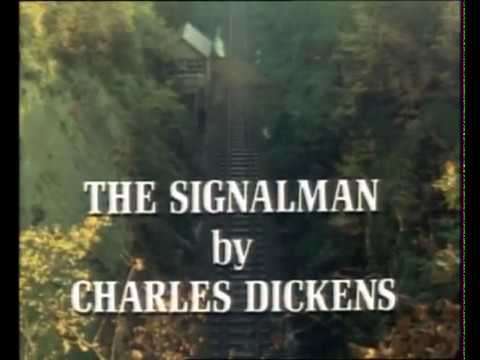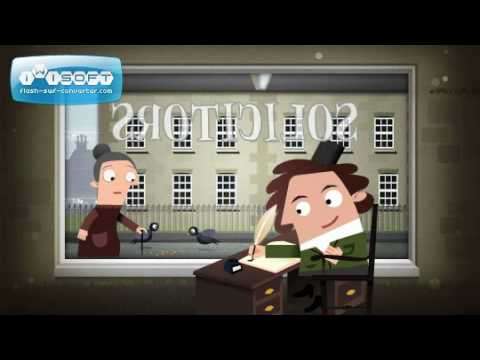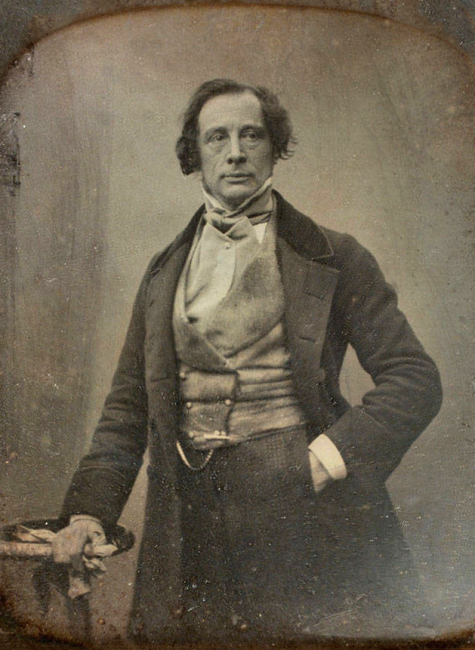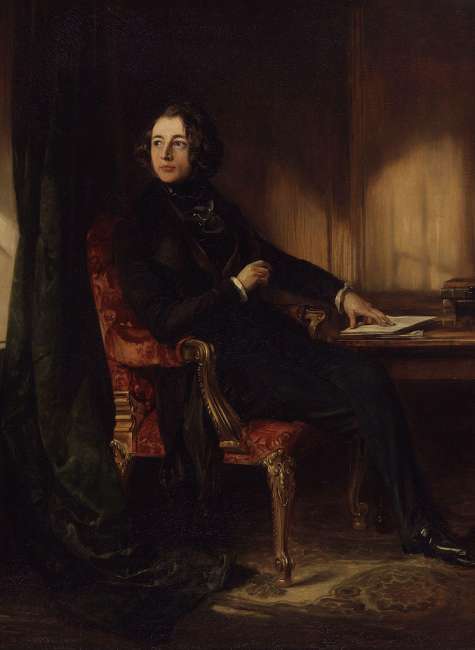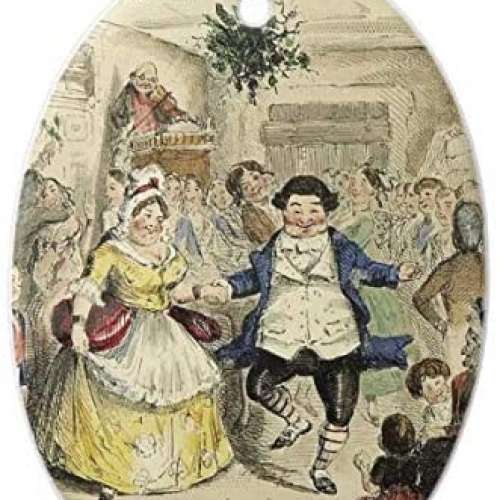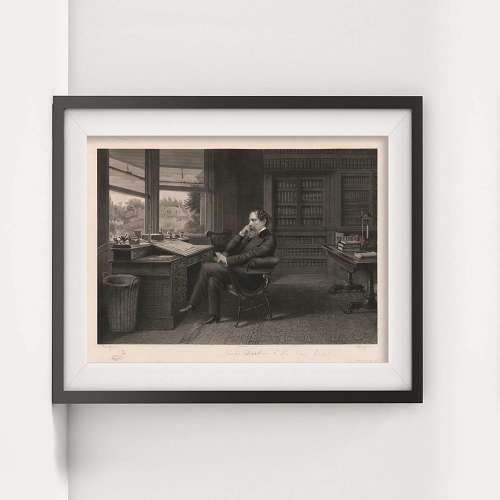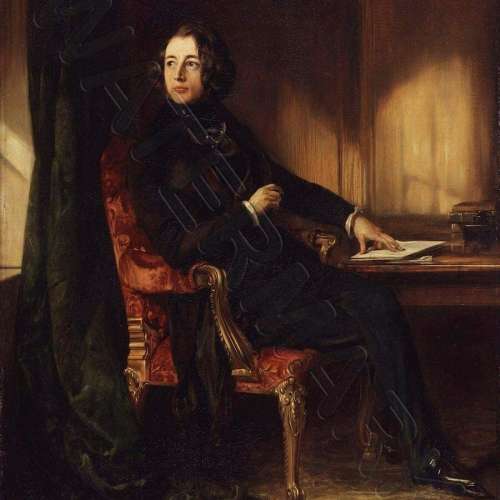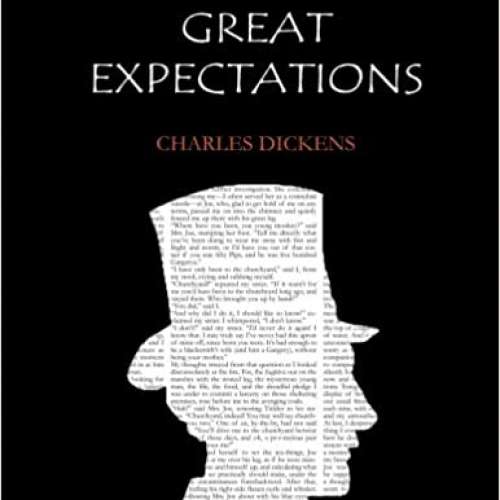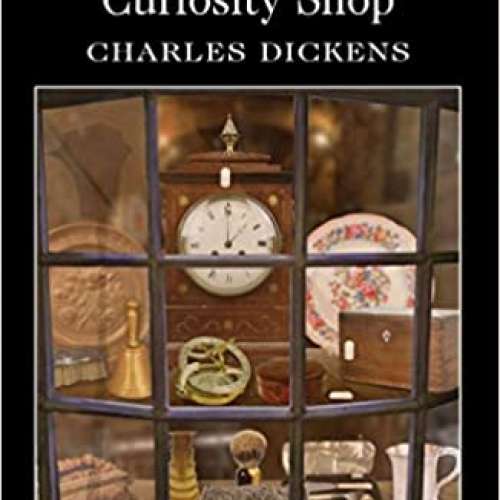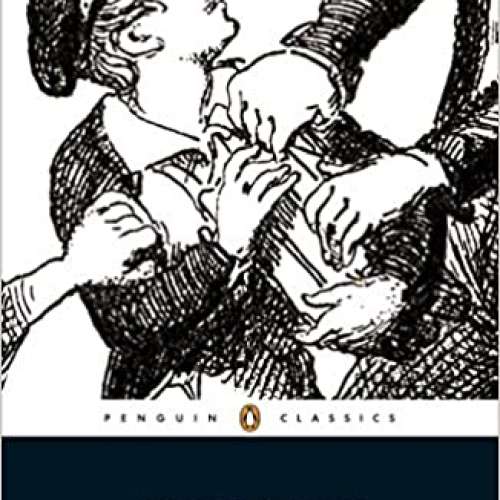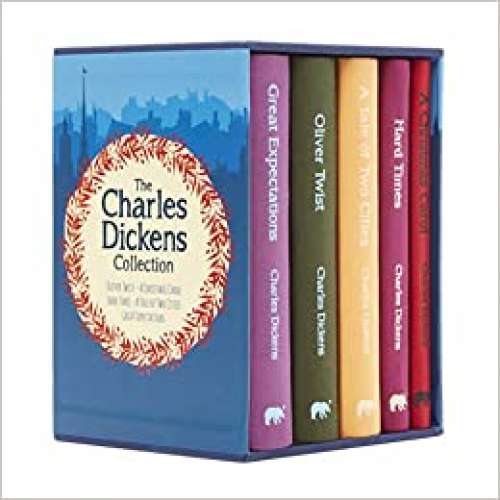

Charles Dickens (1812-1870)

There is nothing in the world so irresistibly contagious as laughter and good humor.
Charles John Huffam Dickens was an English writer and social critic. He created some of the world's best-known fictional characters and is regarded by many as the greatest author of novels of the Victorian era. His works enjoyed unprecedented popularity during his lifetime, and by the 20th century, critics and scholars had recognised him as a literary genius. His novels and short stories are still widely read today and have been adapted into many forms of media.
Born in Portsmouth, Dickens left school to work in a factory when his father was incarcerated in a debtors' prison. Despite his lack of formal education, he edited a weekly journal for 20 years, wrote 15 novels, five novellas, hundreds of short stories and non-fiction articles, lectured and performed readings extensively, was an indefatigable letter writer, and campaigned vigorously for children's rights, education, and other social reforms.
Dickens's literary success began with the 1836 serial publication of The Pickwick Papers. Within a few years he had become an international literary celebrity, famous for his humour, satire, and keen observation of character and society. His novels, most of them published in monthly or weekly instalments, pioneered the serial publication of narrative fiction, which became the dominant Victorian mode for novel publication. Cliffhanger endings in his serial publications kept readers in suspense. The installment format allowed Dickens to evaluate his audience's reaction, and he often modified his plot and character development based on such feedback. For example, when his wife's chiropodist expressed distress at the way Miss Mowcher in David Copperfield seemed to reflect her disabilities, Dickens improved the character with positive features. His plots were carefully constructed, and he often wove elements from topical events into his narratives. Masses of the illiterate poor would individually pay a halfpenny to have each new monthly episode read to them, opening up and inspiring a new class of readers.
His 1843 novella A Christmas Carol remains especially popular and continues to inspire adaptations in every artistic genre. Oliver Twist and Great Expectations are also frequently adapted and, like many of his novels, evoke images of early Victorian London. His 1859 novel A Tale of Two Cities set in London and Paris is his best-known work of historical fiction. The most famous celebrity of his era, he undertook, in response to public demand, a series of public reading tours in the later part of his career. Dickens has been praised by many of his fellow writers – from Leo Tolstoy to George Orwell, G. K. Chesterton, and Tom Wolfe – for his realism, comedy, prose style, unique characterisations, and social criticism. However, Oscar Wilde, Henry James, and Virginia Woolf complained of a lack of psychological depth, loose writing, and a vein of sentimentalism.
The term Dickensian is used to describe something that is reminiscent of Dickens and his writings, such as poor social conditions or comically repulsive characters.
Contents 1 Early years 2 Journalism and early novels 3 First visit to the United States 4 Philanthropy 5 Religious views 6 Middle years 7 Last years 8 Second visit to the United States 9 Farewell readings 10 Death 11 Literary style 11.1 Characters 11.2 Autobiographical elements 11.3 Episodic writing 11.4 Social commentary 11.5 Literary techniques 12 Reputation 13 Influence and legacy 14 Works 15 See also 16 References 16.1 Footnotes 16.2 Notes 16.3 Bibliography 17 Further reading 18 External links 18.1 Works 18.2 Organisations and portals 18.3 Museums 18.4 Other
Early years
Charles John Huffam Dickens was born on 7 February 1812, at 1 Mile End Terrace now 393 Commercial Road, Landport in Portsea Island Portsmouth, the second of eight children of Elizabeth Dickens née Barrow; 1789–1863 and John Dickens 1785–1851. His father was a clerk in the Navy Pay Office and was temporarily stationed in the district. He asked Christopher Huffam, rigger to His Majesty's Navy, gentleman, and head of an established firm, to act as godfather to Charles. Huffam is thought to be the inspiration for Paul Dombey, the owner of a shipping company in Dickens's novel Dombey and Son 1848.
In January 1815, John Dickens was called back to London, and the family moved to Norfolk Street, Fitzrovia. When Charles was four, they relocated to Sheerness, and thence to Chatham, Kent, where he spent his formative years until the age of 11. His early life seems to have been idyllic, though he thought himself a "very small and not-over-particularly-taken-care-of boy".
Charles spent time outdoors, but also read voraciously, including the picaresque novels of Tobias Smollett and Henry Fielding, as well as Robinson Crusoe and Gil Blas. He read and reread The Arabian Nights and the Collected Farces of Elizabeth Inchbald. He retained poignant memories of childhood, helped by an excellent memory of people and events, which he used in his writing. His father's brief work as a clerk in the Navy Pay Office afforded him a few years of private education, first at a dame school, and then at a school run by William Giles, a dissenter, in Chatham.

This period came to an end in June 1822, when John Dickens was recalled to Navy Pay Office headquarters at Somerset House, and the family except for Charles, who stayed behind to finish his final term of work moved to Camden Town in London. The family had left Kent amidst rapidly mounting debts, and, living beyond his means, John Dickens was forced by his creditors into the Marshalsea debtors' prison in Southwark, London in 1824. His wife and youngest children joined him there, as was the practice at the time. Charles, then 12 years old, boarded with Elizabeth Roylance, a family friend, at 112 College Place, Camden Town. Roylance was "a reduced old lady, long known to our family", whom Dickens later immortalised, "with a few alterations and embellishments", as "Mrs Pipchin" in Dombey and Son. Later, he lived in a back-attic in the house of an agent for the Insolvent Court, Archibald Russell, "a fat, good-natured, kind old gentleman... with a quiet old wife" and lame son, in Lant Street in Southwark. They provided the inspiration for the Garlands in The Old Curiosity Shop.
On Sundays—with his sister Frances, free from her studies at the Royal Academy of Music—he spent the day at the Marshalsea. Dickens later used the prison as a setting in Little Dorrit. To pay for his board and to help his family, Dickens was forced to leave school and work ten-hour days at Warren's Blacking Warehouse, on Hungerford Stairs, near the present Charing Cross railway station, where he earned six shillings a week pasting labels on pots of boot blacking. The strenuous and often harsh working conditions made a lasting impression on Dickens and later influenced his fiction and essays, becoming the foundation of his interest in the reform of socio-economic and labour conditions, the rigours of which he believed were unfairly borne by the poor. He later wrote that he wondered "how I could have been so easily cast away at such an age". As he recalled to John Forster from The Life of Charles Dickens:
When the warehouse was moved to Chandos Street in the smart, busy district of Covent Garden, the boys worked in a room in which the window gave onto the street. Small audiences gathered and watched them at work—in Dickens biographer Simon Callow's estimation, the public display was "a new refinement added to his misery".
A few months after his imprisonment, John Dickens's mother, Elizabeth Dickens, died and bequeathed him £450. On the expectation of this legacy, Dickens was released from prison. Under the Insolvent Debtors Act, Dickens arranged for payment of his creditors, and he and his family left Marshalsea, for the home of Mrs Roylance.
Charles's mother, Elizabeth Dickens, did not immediately support his removal from the boot-blacking warehouse. This influenced Dickens's view that a father should rule the family, and a mother find her proper sphere inside the home: "I never afterwards forgot, I never shall forget, I never can forget, that my mother was warm for my being sent back". His mother's failure to request his return was a factor in his dissatisfied attitude towards women.

Righteous indignation stemming from his own situation and the conditions under which working-class people lived became major themes of his works, and it was this unhappy period in his youth to which he alluded in his favourite, and most autobiographical, novel, David Copperfield: "I had no advice, no counsel, no encouragement, no consolation, no assistance, no support, of any kind, from anyone, that I can call to mind, as I hope to go to heaven!"
Dickens was eventually sent to the Wellington House Academy in Camden Town, where he remained until March 1827, having spent about two years there. He did not consider it to be a good school: "Much of the haphazard, desultory teaching, poor discipline punctuated by the headmaster's sadistic brutality, the seedy ushers and general run-down atmosphere, are embodied in Mr Creakle's Establishment in David Copperfield."
Dickens worked at the law office of Ellis and Blackmore, attorneys, of Holborn Court, Gray's Inn, as a junior clerk from May 1827 to November 1828. He was a gifted mimic and impersonated those around him: clients, lawyers, and clerks. He went to theatres obsessively—he claimed that for at least three years he went to the theatre every single day. His favourite actor was Charles Mathews, and Dickens learnt his monopolylogues, farces in which Mathews played every character, by heart. Then, having learned Gurney's system of shorthand in his spare time, he left to become a freelance reporter. A distant relative, Thomas Charlton, was a freelance reporter at Doctors' Commons, and Dickens was able to share his box there to report the legal proceedings for nearly four years. This education was to inform works such as Nicholas Nickleby, Dombey and Son, and especially Bleak House—whose vivid portrayal of the machinations and bureaucracy of the legal system did much to enlighten the general public and served as a vehicle for dissemination of Dickens's own views regarding, particularly, the heavy burden on the poor who were forced by circumstances to "go to law".
In 1830, Dickens met his first love, Maria Beadnell, thought to have been the model for the character Dora in David Copperfield. Maria's parents disapproved of the courtship and ended the relationship by sending her to school in Paris.
Journalism and early novels
In 1832, at the age of 20, Dickens was energetic and increasingly self-confident. He enjoyed mimicry and popular entertainment, lacked a clear, specific sense of what he wanted to become, and yet knew he wanted fame. Drawn to the theatre—he became an early member of the Garrick—he landed an acting audition at Covent Garden, where the manager George Bartley and the actor Charles Kemble were to see him. Dickens prepared meticulously and decided to imitate the comedian Charles Mathews, but ultimately he missed the audition because of a cold. Before another opportunity arose, he had set out on his career as a writer. In 1833, he submitted his first story, "A Dinner at Poplar Walk", to the London periodical Monthly Magazine. William Barrow, Dickens' uncle on his mother's side, offered him a job on The Mirror of Parliament and he worked in the House of Commons for the first time early in 1832. He rented rooms at Furnival's Inn and worked as a political journalist, reporting on Parliamentary debates, and he travelled across Britain to cover election campaigns for the Morning Chronicle. His journalism, in the form of sketches in periodicals, formed his first collection of pieces, published in 1836: Sketches by Boz—Boz being a family nickname he employed as a pseudonym for some years. Dickens apparently adopted it from the nickname "Moses", which he had given to his youngest brother Augustus Dickens, after a character in Oliver Goldsmith's The Vicar of Wakefield. When pronounced by anyone with a head cold, "Moses" became "Boses"—later shortened to Boz. Dickens's own name was considered "queer" by a contemporary critic, who wrote in 1849: "Mr Dickens, as if in revenge for his own queer name, does bestow still queerer ones upon his fictitious creations." Dickens contributed to and edited journals throughout his literary career. In January 1835, the Morning Chronicle launched an evening edition, under the editorship of the Chronicle's music critic, George Hogarth. Hogarth invited him to contribute Street Sketches and Dickens became a regular visitor to his Fulham house—excited by Hogarth's friendship with Walter Scott whom Dickens greatly admired and enjoying the company of Hogarth's three daughters—Georgina, Mary, and nineteen-year-old Catherine.
Dickens made rapid progress both professionally and socially. He began a friendship with William Harrison Ainsworth, the author of the highwayman novel Rookwood 1834, whose bachelor salon in Harrow Road had become the meeting place for a set that included Daniel Maclise, Benjamin Disraeli, Edward Bulwer-Lytton, and George Cruikshank. All these became his friends and collaborators, with the exception of Disraeli, and he met his first publisher, John Macrone, at the house. The success of Sketches by Boz led to a proposal from publishers Chapman and Hall for Dickens to supply text to match Robert Seymour's engraved illustrations in a monthly letterpress. Seymour committed suicide after the second instalment, and Dickens, who wanted to write a connected series of sketches, hired "Phiz" to provide the engravings which were reduced from four to two per instalment for the story. The resulting story became The Pickwick Papers, and though the first few episodes were not successful, the introduction of the Cockney character Sam Weller in the fourth episode the first to be illustrated by Phiz marked a sharp climb in its popularity. The final instalment sold 40,000 copies.

In November 1836, Dickens accepted the position of editor of Bentley's Miscellany, a position he held for three years, until he fell out with the owner. In 1836 as he finished the last instalments of The Pickwick Papers, he began writing the beginning instalments of Oliver Twist—writing as many as 90 pages a month—while continuing work on Bentley's and also writing four plays, the production of which he oversaw. Oliver Twist, published in 1838, became one of Dickens's better known stories, and was the first Victorian novel with a child protagonist.
On 2 April 1836, after a one-year engagement, and between episodes two and three of The Pickwick Papers, Dickens married Catherine Thomson Hogarth 1815–1879, the daughter of George Hogarth, editor of the Evening Chronicle. They were married in St. Luke's Church, Chelsea, London. After a brief honeymoon in Chalk in Kent, the couple returned to lodgings at Furnival's Inn. The first of their ten children, Charley, was born in January 1837, and a few months later the family set up home in Bloomsbury at 48 Doughty Street, London, on which Charles had a three-year lease at £80 a year from 25 March 1837 until December 1839. Dickens's younger brother Frederick and Catherine's 17-year-old sister Mary Hogarth moved in with them. Dickens became very attached to Mary, and she died in his arms after a brief illness in 1837. Unusually for Dickens, as a consequence of his shock, he stopped working, and he and Kate stayed at a little farm on Hampstead Heath for a fortnight. Dickens idealised Mary—the character he fashioned after her, Rose Maylie, he found he could not now kill, as he had planned, in his fiction, and, according to Ackroyd, he drew on memories of her for his later descriptions of Little Nell and Florence Dombey. His grief was so great that he was unable to meet the deadline for the June instalment of The Pickwick Papers and had to cancel the Oliver Twist instalment that month as well. The time in Hampstead was the occasion for a growing bond between Dickens and John Forster to develop; Forster soon became his unofficial business manager, and the first to read his work.
His success as a novelist continued. The young Queen Victoria read both Oliver Twist and Pickwick, staying up until midnight to discuss them. Nicholas Nickleby 1838–39, The Old Curiosity Shop 1840–41 and, finally, his first historical novel, Barnaby Rudge: A Tale of the Riots of 'Eighty, as part of the Master Humphrey's Clock series 1840–41, were all published in monthly instalments before being made into books.

In the midst of all his activity during this period, there was discontent with his publishers and John Macrone was bought off, while Richard Bentley signed over all his rights in Oliver Twist. Other signs of a certain restlessness and discontent emerged—in Broadstairs he flirted with Eleanor Picken, the young fiancée of his solicitor's best friend, and one night grabbed her and ran with her down to the sea. He declared they were both to drown there in the "sad sea waves". She finally got free, and afterward kept her distance. In June 1841 he precipitously set out on a two-month tour of Scotland and then, in September 1841, telegraphed Forster that he had decided to go to America. Master Humphrey's Clock was shut down, though Dickens was still keen on the idea of the weekly magazine, a form he liked, a liking that had begun with his childhood reading of the eighteenth-century magazines Tatler and The Spectator.
Dickens was perturbed by the return to power of the Tories, whom Dickens described as "people whom, politically, I despise and abhor." He had been tempted to stand for the Liberals in Reading, but decided against it due to financial straits. He wrote three anti-Tory verse satires "The Fine Old English Gentleman", "The Quack Doctor's Proclamation", and "Subjects for Painters" which were published in The Examiner.
First visit to the United States
On 22 January 1842, Dickens and his wife arrived in Boston, Massachusetts, aboard the RMS Britannia during their first trip to the United States and Canada. At this time Georgina Hogarth, another sister of Catherine, joined the Dickens household, now living at Devonshire Terrace, Marylebone, to care for the young family they had left behind. She remained with them as housekeeper, organiser, adviser, and friend until Dickens's death in 1870. Dickens modelled the character of Agnes Wickfield after Georgina and Mary.
He described his impressions in a travelogue, American Notes for General Circulation. In Notes, Dickens includes a powerful condemnation of slavery which he had attacked as early as The Pickwick Papers, correlating the emancipation of the poor in England with the abolition of slavery abroad citing newspaper accounts of runaway slaves disfigured by their masters. In spite of the abolitionist sentiments gleaned from his trip to America, some modern commentators have pointed out inconsistencies in Dickens's views on racial inequality. For instance, he has been criticized for his subsequent acquiescence in Governor Eyre's harsh crackdown during the 1860s Morant Bay rebellion in Jamaica and his failure to join other British progressives in condemning it. From Richmond, Virginia, Dickens returned to Washington, D.C., and started a trek westward to St. Louis, Missouri. While there, he expressed a desire to see an American prairie before returning east. A group of 13 men then set out with Dickens to visit Looking Glass Prairie, a trip 30 miles into Illinois.

During his American visit, Dickens spent a month in New York City, giving lectures, raising the question of international copyright laws and the pirating of his work in America. He persuaded a group of twenty-five writers, headed by Washington Irving, to sign a petition for him to take to Congress, but the press were generally hostile to this, saying that he should be grateful for his popularity and that it was mercenary to complain about his work being pirated.
The popularity he gained caused a shift in his self-perception according to critic Kate Flint, who writes that he "found himself a cultural commodity, and its circulation had passed out his control", causing him to become interested in and delve into themes of public and personal personas in the next novels. She writes that he assumed a role of "influential commentator", publicly and in his fiction, evident in his next few books. His trip to the U.S. ended with a trip to Canada: Niagara Falls, Toronto, Kingston and Montreal, where he appeared on stage in light comedies.
Soon after his return to England, Dickens began work on the first of his Christmas stories, A Christmas Carol, written in 1843, which was followed by The Chimes in 1844 and The Cricket on the Hearth in 1845. Of these, A Christmas Carol was most popular and, tapping into an old tradition, did much to promote a renewed enthusiasm for the joys of Christmas in Britain and America. The seeds for the story became planted in Dickens's mind during a trip to Manchester to witness the conditions of the manufacturing workers there. This, along with scenes he had recently witnessed at the Field Lane Ragged School, caused Dickens to resolve to "strike a sledge hammer blow" for the poor. As the idea for the story took shape and the writing began in earnest, Dickens became engrossed in the book. He later wrote that as the tale unfolded he "wept and laughed, and wept again" as he "walked about the black streets of London fifteen or twenty miles many a night when all sober folks had gone to bed."

After living briefly in Italy 1844, Dickens travelled to Switzerland 1846, where he began work on Dombey and Son 1846–48. This and David Copperfield 1849–50 mark a significant artistic break in Dickens's career as his novels became more serious in theme and more carefully planned than his early works.
At about this time, he was made aware of a large embezzlement at the firm where his brother, Augustus, worked John Chapman & Co.. It had been carried out by Thomas Powell, a clerk, who was on friendly terms with Dickens and who had acted as mentor to Augustus when he started work. Powell was also an author and poet and knew many of the famous writers of the day. After further fraudulent activities, Powell fled to New York and published a book called The Living Authors of England with a chapter on Charles Dickens, who was not amused by what Powell had written. One item that seemed to have annoyed him was the assertion that he had based the character of Paul Dombey Dombey and Son on Thomas Chapman, one of the principal partners at John Chapman & Co. Dickens immediately sent a letter to Lewis Gaylord Clark, editor of the New York literary magazine The Knickerbocker, saying that Powell was a forger and thief. Clark published the letter in the New-York Tribune, and several other papers picked up on the story. Powell began proceedings to sue these publications, and Clark was arrested. Dickens, realising that he had acted in haste, contacted John Chapman & Co. to seek written confirmation of Powell's guilt. Dickens did receive a reply confirming Powell's embezzlement, but once the directors realised this information might have to be produced in court, they refused to make further disclosures. Owing to the difficulties of providing evidence in America to support his accusations, Dickens eventually made a private settlement with Powell out of court.
Philanthropy
Angela Burdett Coutts, heir to the Coutts banking fortune, approached Dickens in May 1846 about setting up a home for the redemption of fallen women of the working class. Coutts envisioned a home that would replace the punitive regimes of existing institutions with a reformative environment conducive to education and proficiency in domestic household chores. After initially resisting, Dickens eventually founded the home, named "Urania Cottage", in the Lime Grove section of Shepherds Bush, which he managed for ten years, setting the house rules, reviewing the accounts and interviewing prospective residents. Emigration and marriage were central to Dickens's agenda for the women on leaving Urania Cottage, from which it is estimated that about 100 women graduated between 1847 and 1859.
Religious views
As a young man Dickens expressed a distaste for certain aspects of organised religion. In 1836, in a pamphlet titled Sunday Under Three Heads, he defended the people's right to pleasure, opposing a plan to prohibit games on Sundays. "Look into your churches- diminished congregations and scanty attendance. People have grown sullen and obstinate, and are becoming disgusted with the faith which condemns them to such a day as this, once in every seven. They display their feeling by staying away and mark the rigid gloom that reigns over everything around."

Dickens honoured the figure of Christ. He is regarded as a professing Christian. His son, Henry Fielding Dickens, described him as someone who "possessed deep religious convictions". In the early 1840s he had shown an interest in Unitarian Christianity, and Robert Browning remarked that "Mr Dickens is an enlightened Unitarian." Professor Gary Colledge has written that he "never strayed from his attachment to popular lay Anglicanism". Dickens authored a work called The Life of Our Lord 1846, which is a book about the life of Jesus Christ, written with the purpose of sharing his faith with his children and family.
Dickens disapproved of Roman Catholicism and 19th-century evangelicalism, seeing both as extremes of Christianity and likely to limit personal expression, and was critical of what he saw as the hypocrisy of religious institutions and philosophies like spiritualism, all of which he considered deviations from the true spirit of Christianity, as shown in the book he wrote for his family in 1846. While Dickens advocated equal rights for Catholics in England, he strongly disliked how individual civil liberties were often threatened in countries where Catholicism predominated and referred to the Catholic Church as "that curse upon the world." Dickens also rejected the Evangelical conviction that the Bible was the infallible word of God. His ideas on Biblical interpretation were similar to the Liberal Anglican Arthur Penrhyn Stanley's doctrine of "progressive revelation." Leo Tolstoy and Fyodor Dostoyevsky referred to Dickens as "that great Christian writer".
Middle years
In December 1845, Dickens took up the editorship of the London-based Daily News, a liberal paper through which Dickens hoped to advocate, in his own words, "the Principles of Progress and Improvement, of Education and Civil and Religious Liberty and Equal Legislation." Among the other contributors Dickens chose to write for the paper were the radical economist Thomas Hodgskin and social reformer Douglas William Jerrold, who frequently attacked the Corn Laws. Dickens lasted only ten weeks on the job before resigning due to a combination of exhaustion and frustration with one of the paper's co-owners.
The Francophile Dickens often holidayed in France, and in a speech delivered in Paris in 1846 in French called the French "the first people in the universe". During his visit to Paris, Dickens met the French literati Alexandre Dumas, Victor Hugo, Eugène Scribe, Théophile Gautier, François-René de Chateaubriand and Eugène Sue. In early 1849, Dickens started to write David Copperfield. It was published between 1849 and 1850. In Dickens’ biography, Life of Charles Dickens 1872, John Forster wrote of David Copperfield, “underneath the fiction lay something of the author’s life.” It was Dickens's personal favourite among his own novels, as he wrote in the author's preface to the 1867 edition of the novel.
In late November 1851, Dickens moved into Tavistock House where he wrote Bleak House 1852–53, Hard Times 1854, and Little Dorrit 1856. It was here that he indulged in the amateur theatricals described in Forster's Life. During this period he worked closely with the novelist and playwright Wilkie Collins. In 1856, his income from writing allowed him to buy Gad's Hill Place in Higham, Kent. As a child, Dickens had walked past the house and dreamed of living in it. The area was also the scene of some of the events of Shakespeare's Henry IV, Part 1, and this literary connection pleased him.

During this time Dickens was also the publisher, editor, and a major contributor to the journals Household Words 1850–1859 and All the Year Round 1858–1870. In 1855, when Dickens's good friend and Liberal MP Austen Henry Layard formed an Administrative Reform Association to demand significant reforms of Parliament, Dickens joined and volunteered his resources in support of Layard's cause. With the exception of Lord John Russell, who was the only leading politician in whom Dickens had any faith and to whom he later dedicated A Tale of Two Cities, Dickens believed that the political aristocracy and their incompetence were the death of England. When he and Layard were accused of fomenting class conflict, Dickens replied that the classes were already in opposition and the fault was with the aristocratic class. Dickens used his pulpit in Household Words to champion the Reform Association. He also commented on foreign affairs, declaring his support for Giuseppe Garibaldi and Giuseppe Mazzini, helping raise funds for their campaigns, and stating that "a united Italy would be of vast importance to the peace of the world, and would be a rock in Louis Napoleon's way," and that "I feel for Italy almost as if I were an Italian born."
In 1857, Dickens hired professional actresses for the play The Frozen Deep, written by him and his protégé, Wilkie Collins. Dickens fell in love with one of the actresses, Ellen Ternan, and this passion was to last the rest of his life. Dickens was 45 and Ternan 18 when he made the decision, which went strongly against Victorian convention, to separate from his wife, Catherine, in 1858—divorce was still unthinkable for someone as famous as he was. When Catherine left, never to see her husband again, she took with her one child, leaving the other children to be raised by her sister Georgina who chose to stay at Gad's Hill.
During this period, whilst pondering a project to give public readings for his own profit, Dickens was approached through a charitable appeal by Great Ormond Street Hospital, to help it survive its first major financial crisis. His "Drooping Buds" essay in Household Words earlier on 3 April 1852 was considered by the hospital's founders to have been the catalyst for the hospital's success. Dickens, whose philanthropy was well-known, was asked by his friend, the hospital's founder Charles West, to preside over the appeal, and he threw himself into the task, heart and soul. Dickens's public readings secured sufficient funds for an endowment to put the hospital on a sound financial footing—one reading on 9 February 1858 alone raised £3,000.

After separating from Catherine, Dickens undertook a series of hugely popular and remunerative reading tours which, together with his journalism, were to absorb most of his creative energies for the next decade, in which he was to write only two more novels. His first reading tour, lasting from April 1858 to February 1859, consisted of 129 appearances in 49 towns throughout England, Scotland and Ireland. Dickens's continued fascination with the theatrical world was written into the theatre scenes in Nicholas Nickleby, but more importantly he found an outlet in public readings. In 1866, he undertook a series of public readings in England and Scotland, with more the following year in England and Ireland.
Other works soon followed, including A Tale of Two Cities 1859 and Great Expectations 1861, which were resounding successes. Set in London and Paris, A Tale of Two Cities is his best-known work of historical fiction, and includes the famous opening sentence which begins with.. "It was the best of times, it was the worst of times..". It is regularly cited as one of the best-selling novels of all time. Themes in Great Expectations include wealth and poverty, love and rejection, and the eventual triumph of good over evil.

In early September 1860, in a field behind Gad's Hill, Dickens made a bonfire of most of his correspondence—only those letters on business matters were spared. Since Ellen Ternan also destroyed all of his letters to her, the extent of the affair between the two remains speculative. In the 1930s, Thomas Wright recounted that Ternan had unburdened herself to a Canon Benham, and gave currency to rumours they had been lovers. That the two had a son who died in infancy was alleged by Dickens's daughter, Kate Perugini, whom Gladys Storey had interviewed before her death in 1929. Storey published her account in Dickens and Daughter, but no contemporary evidence exists. On his death, Dickens settled an annuity on Ternan which made her financially independent. Claire Tomalin's book, The Invisible Woman, argues that Ternan lived with Dickens secretly for the last 13 years of his life. The book was subsequently turned into a play, Little Nell, by Simon Gray, and a 2013 film. In the same period, Dickens furthered his interest in the paranormal, becoming one of the early members of The Ghost Club.
In June 1862, he was offered £10,000 for a reading tour of Australia. He was enthusiastic, and even planned a travel book, The Uncommercial Traveller Upside Down, but ultimately decided against the tour. Two of his sons, Alfred D'Orsay Tennyson Dickens and Edward Bulwer Lytton Dickens, migrated to Australia, Edward becoming a member of the Parliament of New South Wales as Member for Wilcannia between 1889 and 1894.
Last years
On 9 June 1865, while returning from Paris with Ellen Ternan, Dickens was involved in the Staplehurst rail crash. The train's first seven carriages plunged off a cast iron bridge that was under repair. The only first-class carriage to remain on the track was the one in which Dickens was travelling. Before rescuers arrived, Dickens tended and comforted the wounded and the dying with a flask of brandy and a hat refreshed with water, and saved some lives. Before leaving, he remembered the unfinished manuscript for Our Mutual Friend, and he returned to his carriage to retrieve it.

Dickens later used the experience of the crash as material for his short ghost story, "The Signal-Man", in which the central character has a premonition of his own death in a rail crash. He also based the story on several previous rail accidents, such as the Clayton Tunnel rail crash of 1861. Dickens managed to avoid an appearance at the inquest to avoid disclosing that he had been travelling with Ternan and her mother, which would have caused a scandal. After the crash Dickens was nervous when travelling by train, and would use alternative means when available. In 1868 he wrote, “I have sudden vague rushes of terror, even when riding in a hansom cab, which are perfectly unreasonable but quite insurmountable." Dickens's son, Henry, recalled, "I have seen him sometimes in a railway carriage when there was a slight jolt. When this happened he was almost in a state of panic and gripped the seat with both hands."
Second visit to the United States
While he contemplated a second visit to the United States, the outbreak of the Civil War in America in 1861 delayed his plans. On 9 November 1867, over two years after the war, Dickens set sail from Liverpool for his second American reading tour. Landing in Boston, he devoted the rest of the month to a round of dinners with such notables as Ralph Waldo Emerson, Henry Wadsworth Longfellow, and his American publisher, James Thomas Fields. In early December, the readings began. He performed 76 readings, netting £19,000, from December 1867 to April 1868. Dickens shuttled between Boston and New York, where he gave 22 readings at Steinway Hall. Although he had started to suffer from what he called the "true American catarrh", he kept to a schedule that would have challenged a much younger man, even managing to squeeze in some sleighing in Central Park.

During his travels, he saw a change in the people and the circumstances of America. His final appearance was at a banquet the American Press held in his honour at Delmonico's on 18 April, when he promised never to denounce America again. By the end of the tour Dickens could hardly manage solid food, subsisting on champagne and eggs beaten in sherry. On 23 April he boarded the Cunard liner Russia to return to Britain, barely escaping a federal tax lien against the proceeds of his lecture tour.
Farewell readings
Between 1868 and 1869, Dickens gave a series of "farewell readings" in England, Scotland, and Ireland, beginning on 6 October. He managed, of a contracted 100 readings, to deliver 75 in the provinces, with a further 12 in London. As he pressed on he was affected by giddiness and fits of paralysis. He suffered a stroke on 18 April 1869 in Chester. He collapsed on 22 April 1869, at Preston in Lancashire, and on doctor's advice, the tour was cancelled. After further provincial readings were cancelled, he began work on his final novel, The Mystery of Edwin Drood. It was fashionable in the 1860s to 'do the slums' and, in company, Dickens visited opium dens in Shadwell, where he witnessed an elderly addict known as "Laskar Sal", who formed the model for the "Opium Sal" subsequently featured in his mystery novel, Edwin Drood.
After Dickens had regained sufficient strength, he arranged, with medical approval, for a final series of readings to partially make up to his sponsors what they had lost due to his illness. There were 12 performances, running between 11 January and 15 March 1870, the last at 8:00 pm at St. James's Hall in London. Although in grave health by this time, he read A Christmas Carol and The Trial from Pickwick. On 2 May, he made his last public appearance at a Royal Academy Banquet in the presence of the Prince and Princess of Wales, paying a special tribute on the death of his friend, the illustrator Daniel Maclise.
Death
On 8 June 1870, Dickens suffered another stroke at his home after a full day's work on Edwin Drood. He never regained consciousness, and the next day, he died at Gads Hill Place. Biographer Claire Tomalin has suggested Dickens was actually in Peckham when he suffered the stroke, and his mistress Ellen Ternan and her maids had him taken back to Gad's Hill so that the public would not know the truth about their relationship. Contrary to his wish to be buried at Rochester Cathedral "in an inexpensive, unostentatious, and strictly private manner", he was laid to rest in the Poets' Corner of Westminster Abbey. A printed epitaph circulated at the time of the funeral reads:
To the Memory of Charles Dickens (England's most popular author) who died at his residence, Higham, near Rochester, Kent, 9 June 1870, aged 58 years. He was a sympathiser with the poor, the suffering, and the oppressed; and by his death, one of England's greatest writers is lost to the world.
His last words were: "On the ground", in response to his sister-in-law Georgina's request that he lie down. On Sunday, 19 June 1870, five days after Dickens was buried in the Abbey, Dean Arthur Penrhyn Stanley delivered a memorial elegy, lauding "the genial and loving humorist whom we now mourn", for showing by his own example "that even in dealing with the darkest scenes and the most degraded characters, genius could still be clean, and mirth could be innocent". Pointing to the fresh flowers that adorned the novelist's grave, Stanley assured those present that "the spot would thenceforth be a sacred one with both the New World and the Old, as that of the representative of literature, not of this island only, but of all who speak our English tongue."

In his will, drafted more than a year before his death, Dickens left the care of his £80,000 estate £7,711,000 in 2019 to his longtime colleague John Forster and his "best and truest friend" Georgina Hogarth who, along with Dickens's two sons, also received a tax-free sum of £8,000 equivalent to £771,000 in 2019. Although Dickens and his wife had been separated for several years at the time of his death, he provided her with an annual income of £600 £57,800 in 2019 and made her similar allowances in his will. He also bequeathed £19 19s £1,900 in 2019 to each servant in his employment at the time of his death.
Literary style
Dickens's approach to the novel is influenced by various things, including the picaresque novel tradition, melodrama, and the novel of sensibility. According to Ackroyd, other than these, perhaps the most important literary influence on him was derived from the fables of The Arabian Nights. Satire and irony are central to the picaresque novel. Comedy is also an aspect of the British picaresque novel tradition of Laurence Sterne, Henry Fielding, and Tobias Smollett. Fielding's Tom Jones was a major influence on the 19th-century novel including Dickens, who read it in his youth, and named a son Henry Fielding Dickens in his honour. Melodrama is typically sensational and designed to appeal strongly to the emotions.
"No one is better qualified to recognise literary genius than a literary genius." —Alfred Harbage on Dickens’ veneration of Shakespeare. A Kind of Power: The Shakespeare-Dickens Analogy 1975.
No other author had such a profound influence on Dickens as William Shakespeare. Regarding Shakespeare as "the great master who knew everything", whose plays "were an unspeakable source of delight", Dickens had a lifelong affinity with the writer, which included seeing theatrical productions of his plays in London and putting on amateur dramatics with friends in his early years. In 1838 Dickens travelled to Stratford-upon-Avon and visited the house in which Shakespeare was born, leaving his autograph in the visitors book. Dickens would draw on this experience in his next work, Nicholas Nickleby 1838–39, expressing the strength of feeling experienced by visitors to Shakespeare’s birthplace: the character Mrs Wititterly states, "I don't know how it is, but after you've seen the place and written your name in the little book, somehow or other you seem to be inspired; it kindles up quite a fire within one."

Dickens’ writing style is marked by a profuse linguistic creativity. Satire, flourishing in his gift for caricature, is his forte. An early reviewer compared him to Hogarth for his keen practical sense of the ludicrous side of life, though his acclaimed mastery of varieties of class idiom may in fact mirror the conventions of contemporary popular theatre. Dickens worked intensively on developing arresting names for his characters that would reverberate with associations for his readers, and assist the development of motifs in the storyline, giving what one critic calls an "allegorical impetus" to the novels' meanings. To cite one of numerous examples, the name Mr Murdstone in David Copperfield conjures up twin allusions to "murder" and stony coldness. His literary style is also a mixture of fantasy and realism. His satires of British aristocratic snobbery—he calls one character the "Noble Refrigerator"—are often popular. Comparing orphans to stocks and shares, people to tug boats, or dinner-party guests to furniture are just some of Dickens's acclaimed flights of fancy.
The author worked closely with his illustrators, supplying them with a summary of the work at the outset and thus ensuring that his characters and settings were exactly how he envisioned them. He briefed the illustrator on plans for each month's instalment so that work could begin before he wrote them. Marcus Stone, illustrator of Our Mutual Friend, recalled that the author was always "ready to describe down to the minutest details the personal characteristics, and ... life-history of the creations of his fancy". Dickens employs Cockney English in many of his works, denoting working class Londoners. Cockney grammar appears in terms such as ain't, and consonants in words are frequently omitted, as in ’ere here, and wot what. An example of this usage is in Oliver Twist. The Artful Dodger uses cockney slang which is juxtaposed with Oliver’s ‘proper’ English, when the Dodger repeats Oliver saying "seven" with "sivin".
Characters
Dickens's biographer Claire Tomalin regards him as the greatest creator of character in English fiction after Shakespeare. Dickensian characters are amongst the most memorable in English literature, especially so because of their typically whimsical names. The likes of Ebenezer Scrooge, Tiny Tim, Jacob Marley and Bob Cratchit A Christmas Carol, Oliver Twist, The Artful Dodger, Fagin and Bill Sikes Oliver Twist, Pip, Miss Havisham and Abel Magwitch Great Expectations, Sydney Carton, Charles Darnay and Madame Defarge A Tale of Two Cities, David Copperfield, Uriah Heep and Mr Micawber David Copperfield, Daniel Quilp The Old Curiosity Shop, Samuel Pickwick and Sam Weller The Pickwick Papers, and Wackford Squeers Nicholas Nickleby are so well known as to be part and parcel of popular culture, and in some cases have passed into ordinary language: a scrooge, for example, is a miser – or someone who dislikes Christmas festivity.

His characters were often so memorable that they took on a life of their own outside his books. "Gamp" became a slang expression for an umbrella from the character Mrs Gamp, and "Pickwickian", "Pecksniffian", and "Gradgrind" all entered dictionaries due to Dickens's original portraits of such characters who were, respectively, quixotic, hypocritical, and vapidly factual. Many were drawn from real life: Mrs Nickleby is based on his mother, though she didn't recognise herself in the portrait, just as Mr Micawber is constructed from aspects of his father's 'rhetorical exuberance': Harold Skimpole in Bleak House is based on James Henry Leigh Hunt: his wife's dwarfish chiropodist recognised herself in Miss Mowcher in David Copperfield. Perhaps Dickens's impressions on his meeting with Hans Christian Andersen informed the delineation of Uriah Heep a term synonymous with sycophant.
Virginia Woolf maintained that "we remodel our psychological geography when we read Dickens" as he produces "characters who exist not in detail, not accurately or exactly, but abundantly in a cluster of wild yet extraordinarily revealing remarks". T. S. Eliot wrote that Dickens "excelled in character; in the creation of characters of greater intensity than human beings." One "character" vividly drawn throughout his novels is London itself. Dickens described London as a magic lantern, inspiring the places and people in many of his novels. From the coaching inns on the outskirts of the city to the lower reaches of the Thames, all aspects of the capital – Dickens' London – are described over the course of his body of work.
Autobiographical elements
Authors frequently draw their portraits of characters from people they have known in real life. David Copperfield is regarded by many as a veiled autobiography of Dickens. The scenes of interminable court cases and legal arguments in Bleak House reflect Dickens's experiences as a law clerk and court reporter, and in particular his direct experience of the law's procedural delay during 1844 when he sued publishers in Chancery for breach of copyright. Dickens's father was sent to prison for debt, and this became a common theme in many of his books, with the detailed depiction of life in the Marshalsea prison in Little Dorrit resulting from Dickens's own experiences of the institution. Lucy Stroughill, a childhood sweetheart, may have affected several of Dickens's portraits of girls such as Little Em'ly in David Copperfield and Lucie Manette in A Tale of Two Cities.

Dickens may have drawn on his childhood experiences, but he was also ashamed of them and would not reveal that this was where he gathered his realistic accounts of squalor. Very few knew the details of his early life until six years after his death, when John Forster published a biography on which Dickens had collaborated. Though Skimpole brutally sends up Leigh Hunt, some critics have detected in his portrait features of Dickens's own character, which he sought to exorcise by self-parody.
Episodic writing
A pioneer of serialised fiction, Dickens wrote most of his major novels in monthly or weekly instalments in journals such as Master Humphrey's Clock and Household Words, later reprinted in book form. These instalments made the stories affordable and accessible, and the series of regular cliffhangers made each new episode widely anticipated. When The Old Curiosity Shop was being serialised, American fans waited at the docks in New York harbor, shouting out to the crew of an incoming British ship, "Is little Nell dead?" Dickens's talent was to incorporate this episodic writing style but still end up with a coherent novel at the end.

Another important impact of Dickens's episodic writing style resulted from his exposure to the opinions of his readers and friends. His friend Forster had a significant hand in reviewing his drafts, an influence that went beyond matters of punctuation. He toned down melodramatic and sensationalist exaggerations, cut long passages such as the episode of Quilp's drowning in The Old Curiosity Shop, and made suggestions about plot and character. It was he who suggested that Charley Bates should be redeemed in Oliver Twist. Dickens had not thought of killing Little Nell, and it was Forster who advised him to entertain this possibility as necessary to his conception of the heroine.
Dickens's serialisation of his novels was criticised by other authors. In Scottish author Robert Louis Stevenson's novel The Wrecker, there is a comment by Captain Nares, investigating an abandoned ship: "See! They were writing up the log," said Nares, pointing to the ink-bottle. "Caught napping, as usual. I wonder if there ever was a captain yet that lost a ship with his log-book up to date? He generally has about a month to fill up on a clean break, like Charles Dickens and his serial novels."
Social commentary
Dickens's novels were, among other things, works of social commentary. He was a fierce critic of the poverty and social stratification of Victorian society. In a New York address, he expressed his belief that "Virtue shows quite as well in rags and patches as she does in purple and fine linen". Dickens's second novel, Oliver Twist 1839, shocked readers with its images of poverty and crime: it challenged middle class polemics about criminals, making impossible any pretence to ignorance about what poverty entailed.

At a time when Britain was the major economic and political power of the world, Dickens highlighted the life of the forgotten poor and disadvantaged within society. Through his journalism he campaigned on specific issues—such as sanitation and the workhouse—but his fiction probably demonstrated its greatest prowess in changing public opinion in regard to class inequalities. He often depicted the exploitation and oppression of the poor and condemned the public officials and institutions that not only allowed such abuses to exist, but flourished as a result. His most strident indictment of this condition is in Hard Times 1854, Dickens's only novel-length treatment of the industrial working class. In this work, he uses vitriol and satire to illustrate how this marginalised social stratum was termed "Hands" by the factory owners; that is, not really "people" but rather only appendages of the machines they operated. His writings inspired others, in particular journalists and political figures, to address such problems of class oppression. For example, the prison scenes in The Pickwick Papers are claimed to have been influential in having the Fleet Prison shut down. Karl Marx asserted that Dickens "issued to the world more political and social truths than have been uttered by all the professional politicians, publicists and moralists put together". George Bernard Shaw even remarked that Great Expectations was more seditious than Marx's Das Kapital. The exceptional popularity of Dickens's novels, even those with socially oppositional themes Bleak House, 1853; Little Dorrit, 1857; Our Mutual Friend, 1865, not only underscored his ability to create compelling storylines and unforgettable characters, but also ensured that the Victorian public confronted issues of social justice that had commonly been ignored. It has been argued that his technique of flooding his narratives with an 'unruly superfluity of material' that, in the gradual dénouement, yields up an unsuspected order, influenced the organisation of Charles Darwin's On the Origin of Species.
Literary techniques
Dickens is often described as using idealised characters and highly sentimental scenes to contrast with his caricatures and the ugly social truths he reveals. The story of Nell Trent in The Old Curiosity Shop 1841 was received as extraordinarily moving by contemporary readers but viewed as ludicrously sentimental by Oscar Wilde. "One must have a heart of stone to read the death of little Nell", he said in a famous remark, "without dissolving into tears...of laughter." G. K. Chesterton stated, "It is not the death of little Nell, but the life of little Nell, that I object to", arguing that the maudlin effect of his description of her life owed much to the gregarious nature of Dickens's grief, his "despotic" use of people's feelings to move them to tears in works like this.

The question as to whether Dickens belongs to the tradition of the sentimental novel is debatable. Valerie Purton, in her book Dickens and the Sentimental Tradition, sees him continuing aspects of this tradition, and argues that his "sentimental scenes and characters as crucial to the overall power of the novels as his darker or comic figures and scenes", and that "Dombey and Son is Dickens's greatest triumph in the sentimentalist tradition". The Encyclopædia Britannica online comments that, despite "patches of emotional excess", such as the reported death of Tiny Tim in A Christmas Carol 1843, "Dickens cannot really be termed a sentimental novelist".
In Oliver Twist Dickens provides readers with an idealised portrait of a boy so inherently and unrealistically good that his values are never subverted by either brutal orphanages or coerced involvement in a gang of young pickpockets. While later novels also centre on idealised characters Esther Summerson in Bleak House and Amy Dorrit in Little Dorrit, this idealism serves only to highlight Dickens's goal of poignant social commentary. Dickens's fiction, reflecting what he believed to be true of his own life, makes frequent use of coincidence, either for comic effect or to emphasise the idea of providence. For example, Oliver Twist turns out to be the lost nephew of the upper-class family that rescues him from the dangers of the pickpocket group. Such coincidences are a staple of 18th-century picaresque novels, such as Henry Fielding's Tom Jones, which Dickens enjoyed reading as a youth.
Reputation
Dickens was the most popular novelist of his time, and remains one of the best-known and most-read of English authors. His works have never gone out of print, and have been adapted continually for the screen since the invention of cinema, with at least 200 motion pictures and TV adaptations based on Dickens's works documented. Many of his works were adapted for the stage during his own lifetime, and as early as 1913, a silent film of The Pickwick Papers was made. Contemporaries such as publisher Edward Lloyd cashed in on Dickens’ popularity with cheap imitations of his novels – resulting in his own popular ‘penny dreadfuls’.
From the beginning of his career in the 1830s, Dickens’ achievements in English literature were compared to those of Shakespeare. Dickens created some of the world's best-known fictional characters and is regarded by many as the greatest British novelist of the Victorian era. His literary reputation, however began to decline with the publication of Bleak House in 1852–53. Philip Collins calls Bleak House ‘a crucial item in the history of Dickens's reputation. Reviewers and literary figures during the 1850s, 1860s and 1870s, saw a "drear decline" in Dickens, from a writer of "bright sunny comedy ... to dark and serious social" commentary. The Spectator called Bleak House "a heavy book to read through at once ... dull and wearisome as a serial"; Richard Simpson, in The Rambler, characterized Hard Times as ‘this dreary framework’; Fraser's Magazine thought Little Dorrit ‘decidedly the worst of his novels’. All the same, despite these "increasing reservations amongst reviewers and the chattering classes, ‘the public never deserted its favourite’". Dickens's popular reputation remained unchanged, sales continued to rise, and Household Words and later All the Year Round were highly successful.

“Dickens's vocal impersonations of his own characters gave this truth a theatrical form: the public reading tour. No other Victorian could match him for celebrity, earnings, and sheer vocal artistry. The Victorians craved the author's multiple voices: between 1853 and his death in 1870, Dickens performed about 470 times.” —Peter Garratt in The Guardian on Dickens’ fame and the demand for his public readings.
Later in his career, Dickens’ fame and the demand for his public readings were unparalleled. In 1868 The Times wrote, "Amid all the variety of 'readings', those of Mr Charles Dickens stand alone.” A Dickens biographer, Edgar Johnson, wrote in the 1950s: "It was more than a reading; it was an extraordinary exhibition of acting that seized upon its auditors with a mesmeric possession." Comparing his reception at public readings to those of a contemporary pop star, The Guardian states, “People sometimes fainted at his shows. His performances even saw the rise of that modern phenomenon, the "speculator" or ticket tout scalpers – the ones in New York City escaped detection by borrowing respectable-looking hats from the waiters in nearby restaurants.”
Among fellow writers, there was a range of opinions on Dickens. Poet laureate, William Wordsworth 1770–1850, thought him a "very talkative, vulgar young person", adding he had not read a line of his work, while novelist George Meredith 1828–1909, found Dickens "intellectually lacking". In 1888 Leslie Stephen commented in the Dictionary of National Biography that "if literary fame could be safely measured by popularity with the half-educated, Dickens must claim the highest position among English novelists". Anthony Trollope's Autobiography famously declared Thackeray, not Dickens, to be the greatest novelist of the age. However, both Leo Tolstoy and Fyodor Dostoyevsky were admirers. Dostoyevsky commented: "We understand Dickens in Russia, I am convinced, almost as well as the English, perhaps even with all the nuances. It may well be that we love him no less than his compatriots do. And yet how original is Dickens, and how very English!" Tolstoy referred to David Copperfield as his favourite book, and he later adopted the novel as “a model for his own autobiographical reflections.” French writer Jules Verne called Dickens his favourite writer, writing his novels "stand alone, dwarfing all others by their amazing power and felicity of expression". Dutch painter Vincent van Gogh was inspired by Dickens's novels in several of his paintings like Vincent's Chair and in an 1889 letter to his sister stated that reading Dickens, especially A Christmas Carol, was one of the things that was keeping him from committing suicide. Oscar Wilde generally disparaged his depiction of character, while admiring his gift for caricature. Henry James denied him a premier position, calling him "the greatest of superficial novelists": Dickens failed to endow his characters with psychological depth and the novels, "loose baggy monsters", betrayed a "cavalier organisation". Joseph Conrad described his own childhood in bleak Dickensian terms, and noted he had "an intense and unreasoning affection" for Bleak House, dating back to his boyhood. The novel influenced his own gloomy portrait of London in The Secret Agent 1907. Virginia Woolf had a love-hate relationship with his works, finding his novels "mesmerizing" while reproving him for his sentimentalism and a commonplace style.
Around 1940–41 the attitude of the literary critics began to warm towards Dickens—led by George Orwell in Inside the Whale and Other Essays March 1940, Edmund Wilson in The Wound and the Bow 1941, and Humphry House in Dickens and his World. However, even in 1948, F. R. Leavis, in The Great Tradition, asserted that "the adult mind doesn't as a rule find in Dickens a challenge to an unusual and sustained seriousness"; Dickens was indeed a great genius, "but the genius was that of a great entertainer", though he later changed his opinion with Dickens the Novelist 1970, with Q. D. Queenie Leavis: "Our purpose", they wrote, "is to enforce as unanswerably as possible the conviction that Dickens was one of the greatest of creative writers". In 1944, Soviet film director and film theorist Sergei Eisenstein wrote an essay on Dickens's influence on cinema, such as cross-cutting—where two stories run alongside each other, as seen in novels such as Oliver Twist.
In the 1950s, "a substantial reassessment and re-editing of the works began, and critics found his finest artistry and greatest depth to be in the later novels: Bleak House, Little Dorrit, and Great Expectations—and less unanimously in Hard Times and Our Mutual Friend". Dickens was a favourite author of Roald Dahl’s; the best-selling children’s author would include three of Dickens’ novels among those read by the title character in his 1988 novel Matilda. An avid reader of Dickens, in 2005, Paul McCartney named Nicholas Nickleby his favourite novel. On Dickens he states, “I like the world that he takes me to. I like his words; I like the language”, adding, “A lot of my stuff – it's kind of Dickensian.” Screenwriter Jonathan Nolan’s screenplay for The Dark Knight Rises 2012 was inspired by A Tale of Two Cities, with Nolan calling the depiction of Paris in the novel “one of the most harrowing portraits of a relatable, recognisable civilisation that completely folded to pieces”. On 7 February 2012, the 200th anniversary of Dickens's birth, Philip Womack wrote in The Telegraph: "Today there is no escaping Charles Dickens. Not that there has ever been much chance of that before. He has a deep, peculiar hold upon us".
Influence and legacy
Museums and festivals celebrating Dickens's life and works exist in many places with which Dickens was associated. These include the Charles Dickens Museum in London, the historic home where he wrote Oliver Twist, The Pickwick Papers and Nicholas Nickleby; and the Charles Dickens Birthplace Museum in Portsmouth, the house in which he was born. The original manuscripts of many of his novels, as well as printers' proofs, first editions, and illustrations from the collection of Dickens's friend John Forster are held at the Victoria and Albert Museum. Dickens's will stipulated that no memorial be erected in his honour; nonetheless, a life-size bronze statue of Dickens entitled Dickens and Little Nell, cast in 1891 by Francis Edwin Elwell, stands in Clark Park in the Spruce Hill neighbourhood of Philadelphia, Pennsylvania. Another life-size statue of Dickens is located at Centennial Park, Sydney, Australia. In 1960 a bass relief sculpture of Dickens, notably featuring characters from his books, was commissioned from sculptor Estcourt J Clack to adorn the office building built on the site of his former home at 1 Devonshire Terrace, London. In 2014, a life-size statue was unveiled near his birthplace in Portsmouth on the 202nd anniversary of his birth; this was supported by the author's great-great grandsons, Ian and Gerald Dickens.
A Christmas Carol is most probably his best-known story, with frequent new adaptations. It is also the most-filmed of Dickens's stories, with many versions dating from the early years of cinema. According to the historian Ronald Hutton, the current state of the observance of Christmas is largely the result of a mid-Victorian revival of the holiday spearheaded by A Christmas Carol. Dickens catalysed the emerging Christmas as a family-centred festival of generosity, in contrast to the dwindling community-based and church-centred observations, as new middle-class expectations arose. Its archetypal figures Scrooge, Tiny Tim, the Christmas ghosts entered into Western cultural consciousness. "Merry Christmas", a prominent phrase from the tale, was popularised following the appearance of the story. The term Scrooge became a synonym for miser, and his dismissive exclamation 'Bah! Humbug!' likewise gained currency as an idiom. Novelist William Makepeace Thackeray called the book "a national benefit, and to every man and woman who reads it a personal kindness".
Dickens was commemorated on the Series E £10 note issued by the Bank of England that circulated between 1992 and 2003. His portrait appeared on the reverse of the note accompanied by a scene from The Pickwick Papers. The Charles Dickens School is a high school in Broadstairs, Kent. A theme park, Dickens World, standing in part on the site of the former naval dockyard where Dickens's father once worked in the Navy Pay Office, opened in Chatham in 2007. To celebrate the 200th anniversary of the birth of Charles Dickens in 2012, the Museum of London held the UK's first major exhibition on the author in 40 years. In 2002, Dickens was number 41 in the BBC's poll of the 100 Greatest Britons. American literary critic Harold Bloom placed Dickens among the greatest Western writers of all time. In the 2003 UK survey The Big Read carried out by the BBC, five of Dickens's books were named in the Top 100.
Dickens and his publications have appeared on a number of postage stamps including: UK 1970, 1993, 2011 and 2012, Soviet Union 1962, Antigua, Barbuda, Botswana, Cameroon, Dubai, Fujairah, St Christopher, Nevis and Anguilla, St Helena, St Lucia and Turks and Caicos Islands 1970, St Vincent 1987, Nevis 2007, Alderney, Gibraltar, Jersey and Pitcairn Islands 2012, Austria 2013, Mozambique 2014.
In November 2018 it was reported that a previously lost portrait of a 31-year-old Dickens, by Margaret Gillies, had been found in Pietermaritzburg, South Africa. Gillies was an early supporter of women's suffrage and had painted the portrait in late 1843 when Dickens, aged 31, wrote A Christmas Carol. It was exhibited, to acclaim, at the Royal Academy of Arts in 1844.
Works
Dickens published well over a dozen major novels and novellas, a large number of short stories, including a number of Christmas-themed stories, a handful of plays, and several non-fiction books. Dickens's novels were initially serialised in weekly and monthly magazines, then reprinted in standard book formats.
- The Pickwick Papers The Posthumous Papers of the Pickwick Club; monthly serial, April 1836 to November 1837
- Oliver Twist The Adventures of Oliver Twist; monthly serial in Bentley's Miscellany, February 1837 to April 1839
- Nicholas Nickleby The Life and Adventures of Nicholas Nickleby; monthly serial, April 1838 to October 1839
- The Old Curiosity Shop weekly serial in Master Humphrey's Clock, April 1840 to November 1841
- Barnaby Rudge Barnaby Rudge: A Tale of the Riots of Eighty; weekly serial in Master Humphrey's Clock, February to November 1841
- A Christmas Carol A Christmas Carol in Prose: Being a Ghost-story of Christmas; 1843
- Martin Chuzzlewit The Life and Adventures of Martin Chuzzlewit; monthly serial, January 1843 to July 1844
- The Chimes The Chimes: A Goblin Story of Some Bells That Rang an Old Year Out and a New Year In; 1844
- The Cricket on the Hearth The Cricket on the Hearth: A Fairy Tale of Home; 1845
- Dombey and Son Dealings with the Firm of Dombey and Son: Wholesale, Retail and for Exportation; monthly serial, October 1846 to April 1848
- The Haunted Man The Haunted Man and the Ghost's Bargain: A Fancy for Christmas-time; 1848
- David Copperfield The Personal History, Adventures, Experience and Observation of David Copperfield the Younger of Blunderstone Rookery ; monthly serial, May 1849 to November 1850
- Bleak House monthly serial, March 1852 to September 1853
- Hard Times Hard Times: For These Times; weekly serial in Household Words, 1 April 1854, to 12 August 1854
- Little Dorrit monthly serial, December 1855 to June 1857
- A Tale of Two Cities weekly serial in All the Year Round, 30 April 1859, to 26 November 1859
- Great Expectations weekly serial in All the Year Round, 1 December 1860 to 3 August 1861
- Our Mutual Friend monthly serial, May 1864 to November 1865
- The Signal Man, first published as part of the Mugby Junction collection in the 1866 Christmas edition of All the Year Round.
- Edwin Drood The Mystery of Edwin Drood; monthly serial, April 1870 to September 1870, left unfinished due to Dickens's death
More facts
Oliver Twist
Nicholas Nickleby
A Christmas Carol
David Copperfield
Bleak House
Little Dorrit
A Tale of Two Cities
Great Expectations
Mary Dickens
Kate Perugini
Walter Landor Dickens
Francis Dickens
Alfred D'Orsay Tennyson Dickens
Sydney Smith Haldimand Dickens
Henry Fielding Dickens
Dora Annie Dickens
Edward Dickens
David Copperfield (1935)
A Christmas Carol (1951)
Oliver! (1968)
Great Expectations (1998)

